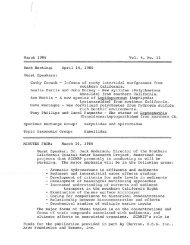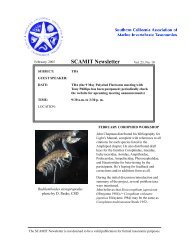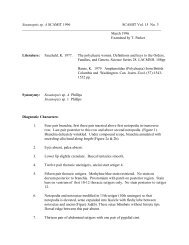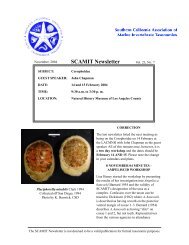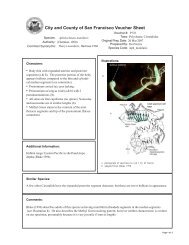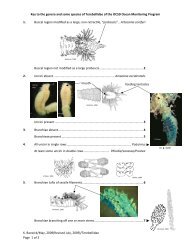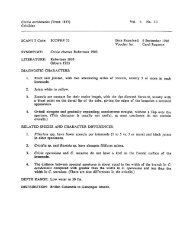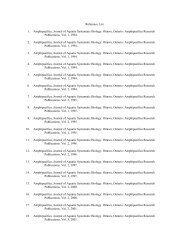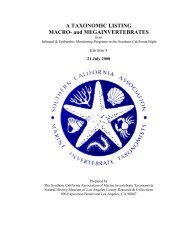A Taxonomic Listing of Benthic Macro- and Megainvertebrates - scamit
A Taxonomic Listing of Benthic Macro- and Megainvertebrates - scamit
A Taxonomic Listing of Benthic Macro- and Megainvertebrates - scamit
- No tags were found...
You also want an ePaper? Increase the reach of your titles
YUMPU automatically turns print PDFs into web optimized ePapers that Google loves.
place since as early as 1972. There is substantial potential for confusion <strong>of</strong> species<br />
identities because <strong>of</strong> the many taxonomists involved over the period. Every species name<br />
on the base list was subject to review <strong>and</strong> discussion prior to acceptance on the final list.<br />
Names retained were those 1) found to have been applied to taxa recognized as unique <strong>and</strong><br />
2) for which consensus among SCAMIT reviewers existed as to the name used to represent<br />
these taxa. Consensus here does not imply unanimity <strong>of</strong> opinion, but an agreement to<br />
accept a st<strong>and</strong>ard use <strong>of</strong> a name in the interest <strong>of</strong> regional conformity. Conflicts <strong>of</strong> opinion<br />
were resolved by review <strong>of</strong> appropriate literature <strong>and</strong>, in many cases, re-examination <strong>of</strong><br />
voucher specimens by the reviewers.<br />
Following compilation <strong>of</strong> the list from the four largest programs, encountered-species lists<br />
from monitoring programs conducted by the smaller POTWs in the Bight <strong>and</strong> studies by the<br />
Southern California Coastal Water Research Project (SCCWRP) were reviewed. This latter<br />
stage was hindered by the general absence in the smaller monitoring programs <strong>of</strong> easily<br />
accessible databases from which to draw encountered-species lists, frequent changes in<br />
contractors performing the sample analysis, <strong>and</strong> the unavailability <strong>of</strong> the taxonomists<br />
responsible for the data. The encountered-species lists received were typically from the<br />
most recent surveys, although the actual time spans were not given. Approximately 10% <strong>of</strong><br />
the species on the final list were added as a result <strong>of</strong> review <strong>of</strong> the small POTW<br />
encountered-species lists.<br />
The process <strong>of</strong> compilation resulted in a list, which is generally exclusive in nature. Many<br />
taxa names reported in the contributed species lists were eliminated by the reviewers,<br />
frequently because <strong>of</strong> the absence <strong>of</strong> voucher specimens or documentation allowing their<br />
confirmation. Inevitably, some taxa names eliminated will later be found acceptable. In<br />
addition, voucher specimens were not examined in all cases <strong>and</strong> some taxa deemed<br />
uncontroversial may later be discovered to be inconsistent in application or otherwise<br />
unacceptable. It is anticipated that this list will grow <strong>and</strong> change during future updates.<br />
The first edition (1994) drew upon the encountered-species lists <strong>of</strong> 16 infaunal monitoring programs<br />
in the region. Subsequent editions built upon the first through a similar process <strong>of</strong> addition <strong>and</strong><br />
emendation. In each edition newly detected taxa were added, nomenclatural revisions were<br />
incorporated, <strong>and</strong> errors in the previous edition corrected. Previously listed names found to be based<br />
upon doubtful or unverifiable records were dropped from the list. Provisional species names lacking<br />
adequate characterization or uniformity <strong>of</strong> application within the region were also dropped.<br />
The second edition (1996) included, for the first time, epibenthic invertebrates taken in trawl<br />
surveys within the Bight as well as new records from the surveys conducted as part <strong>of</strong> the 1994<br />
Southern California Bight Pilot Project. This regional project included surveys <strong>of</strong> mainl<strong>and</strong> coastal<br />
s<strong>of</strong>t-bottom infaunal <strong>and</strong> epibenthic communities from Pt. Conception to the US/Mexico border,<br />
employing the same techniques used in POTW monitoring programs.<br />
The third edition (1998) was enlarged by the inclusion <strong>of</strong> abbreviated synonymies. These presented<br />
both valid synonyms <strong>and</strong> synonyms based upon nomenclatural usage. They were not exhaustive,<br />
but rather sought to provide examples <strong>of</strong> the various combinations under which a name has occurred<br />
with an emphasis on usage in the Southern California Bight <strong>and</strong> the Northeast Pacific. An<br />
explanation <strong>of</strong> the notation employed in synonymies is provided below.<br />
The fourth edition (2001) continued to grow in coverage by accretion. Abbreviated synonymies<br />
were enlarged as more information became available. The range <strong>of</strong> habitats examined exp<strong>and</strong>ed by<br />
inclusion <strong>of</strong> results <strong>of</strong> the second regional survey (B’98), which sampled bays, estuaries, <strong>of</strong>fshore<br />
isl<strong>and</strong> shelves, <strong>and</strong> northwestern Baja California.<br />
The fifth edition (2008) incorporated additional records from habitats little covered in previous<br />
editions, particularly the upper continental slope, bays <strong>and</strong> harbors. It reflected many changes,<br />
6



